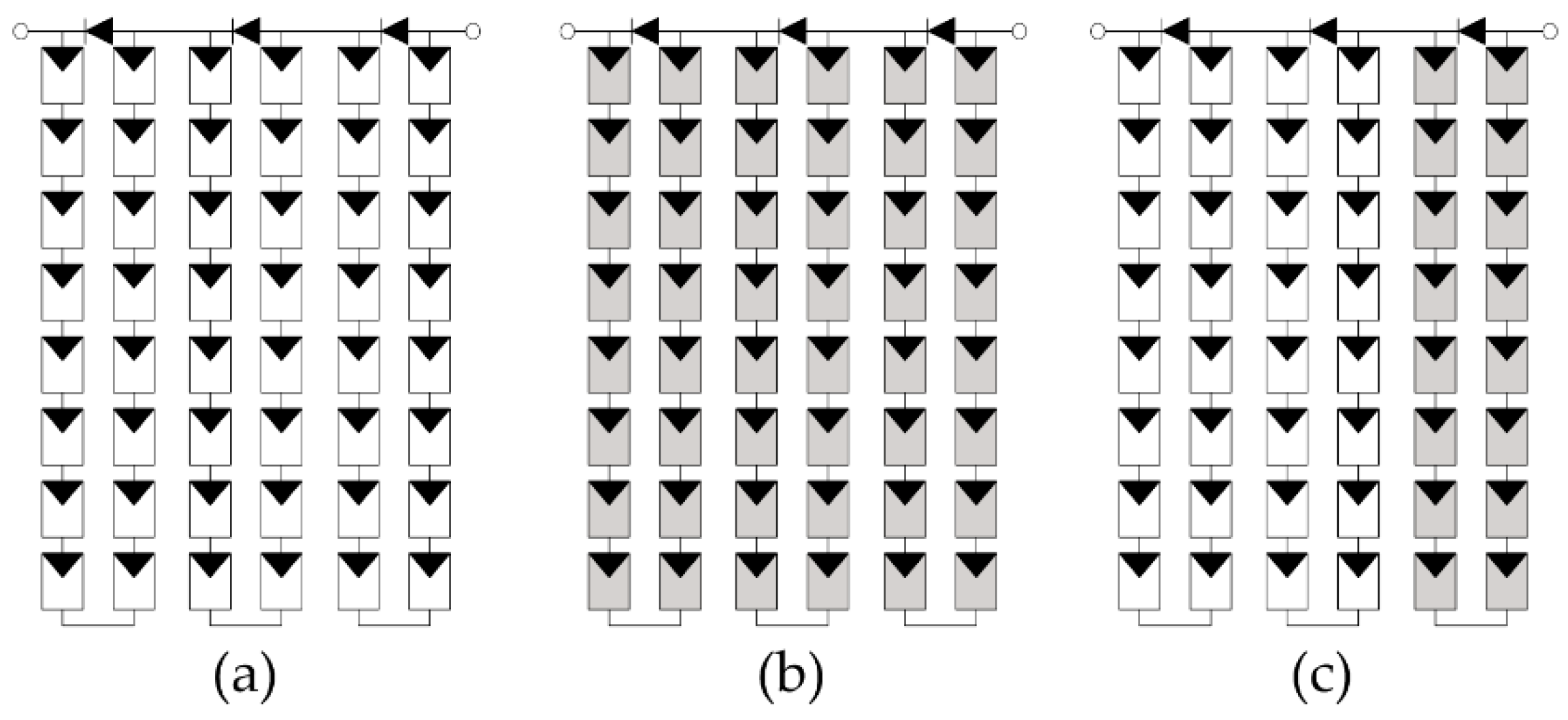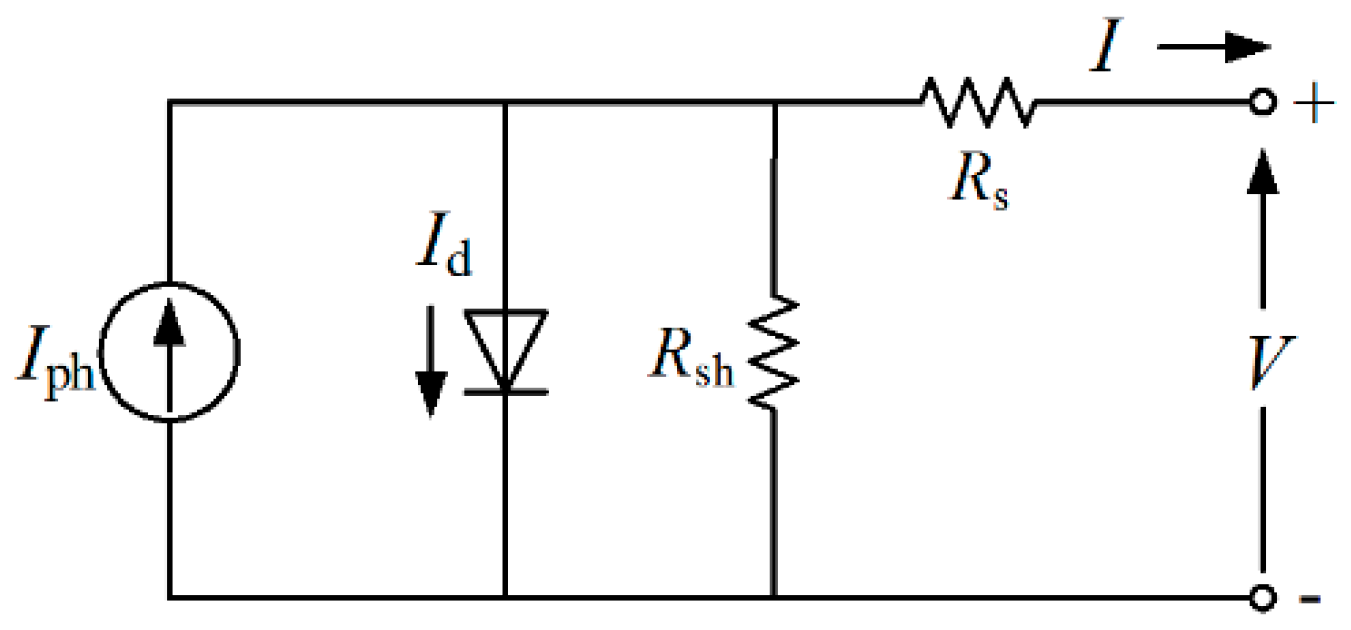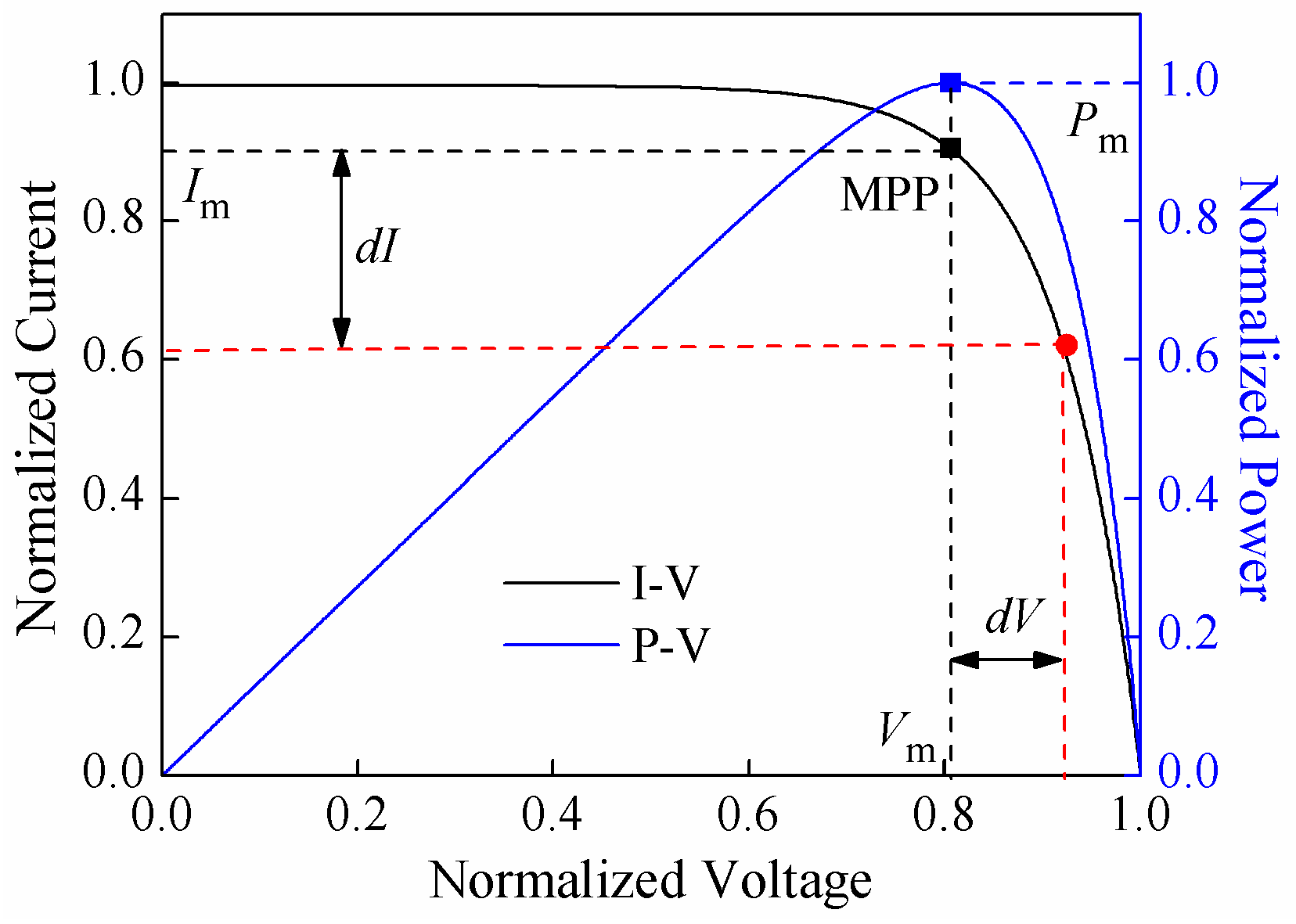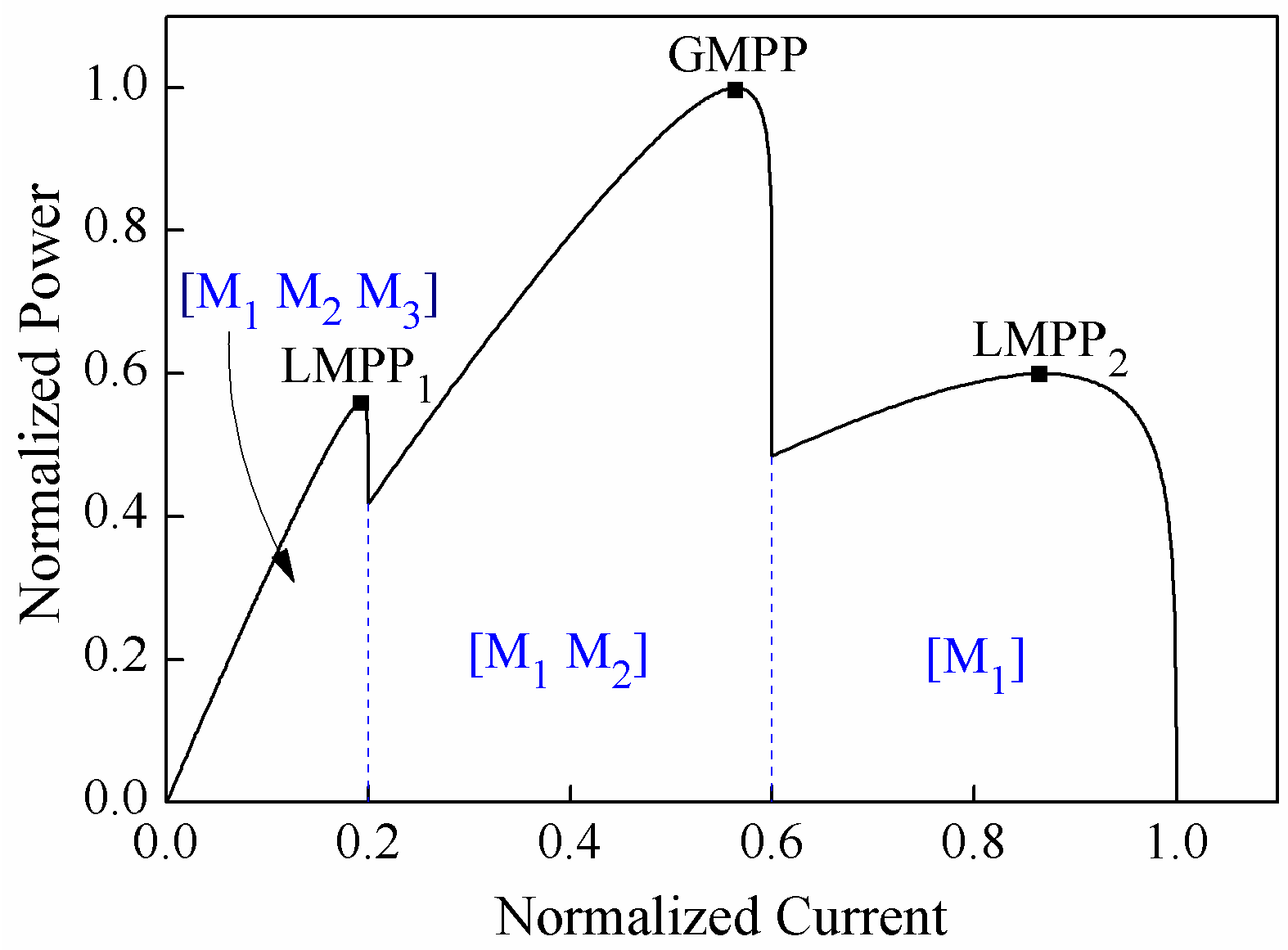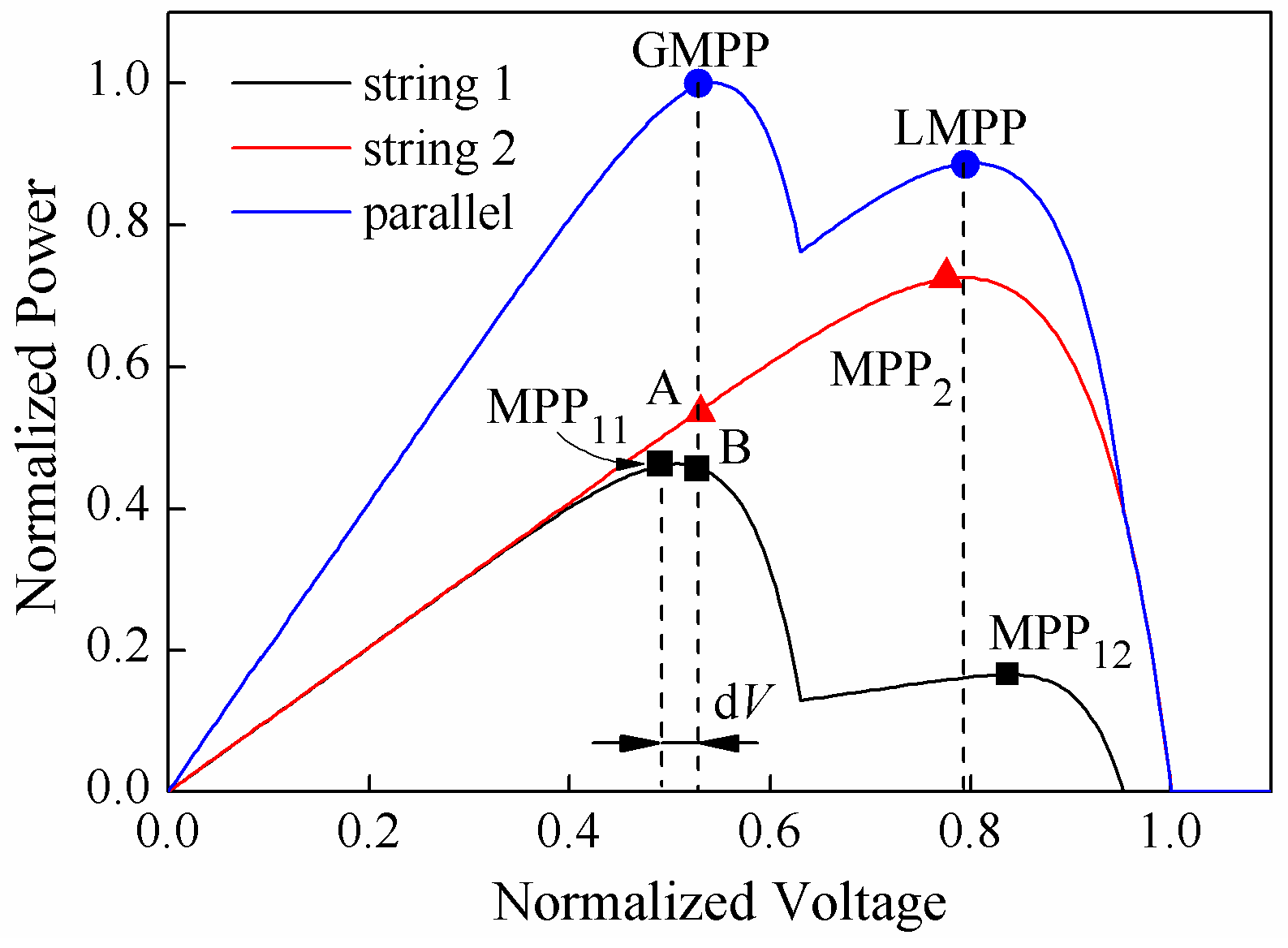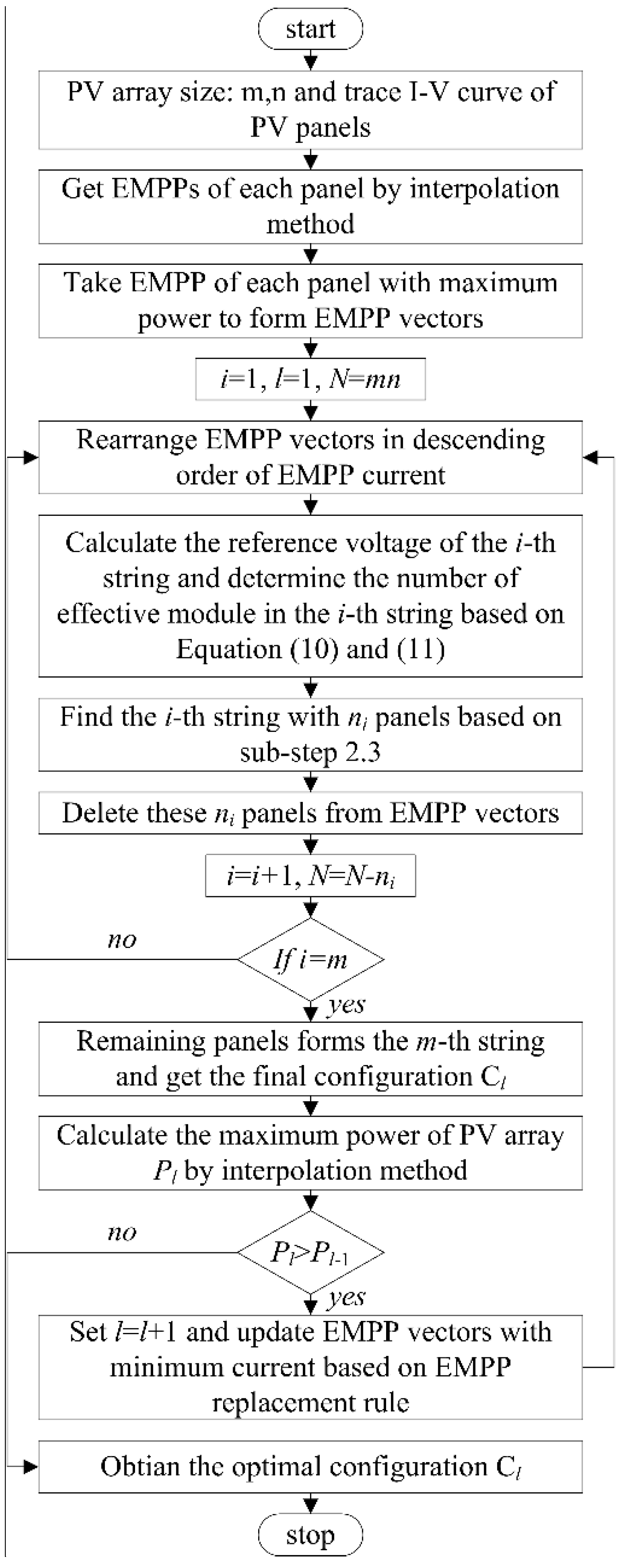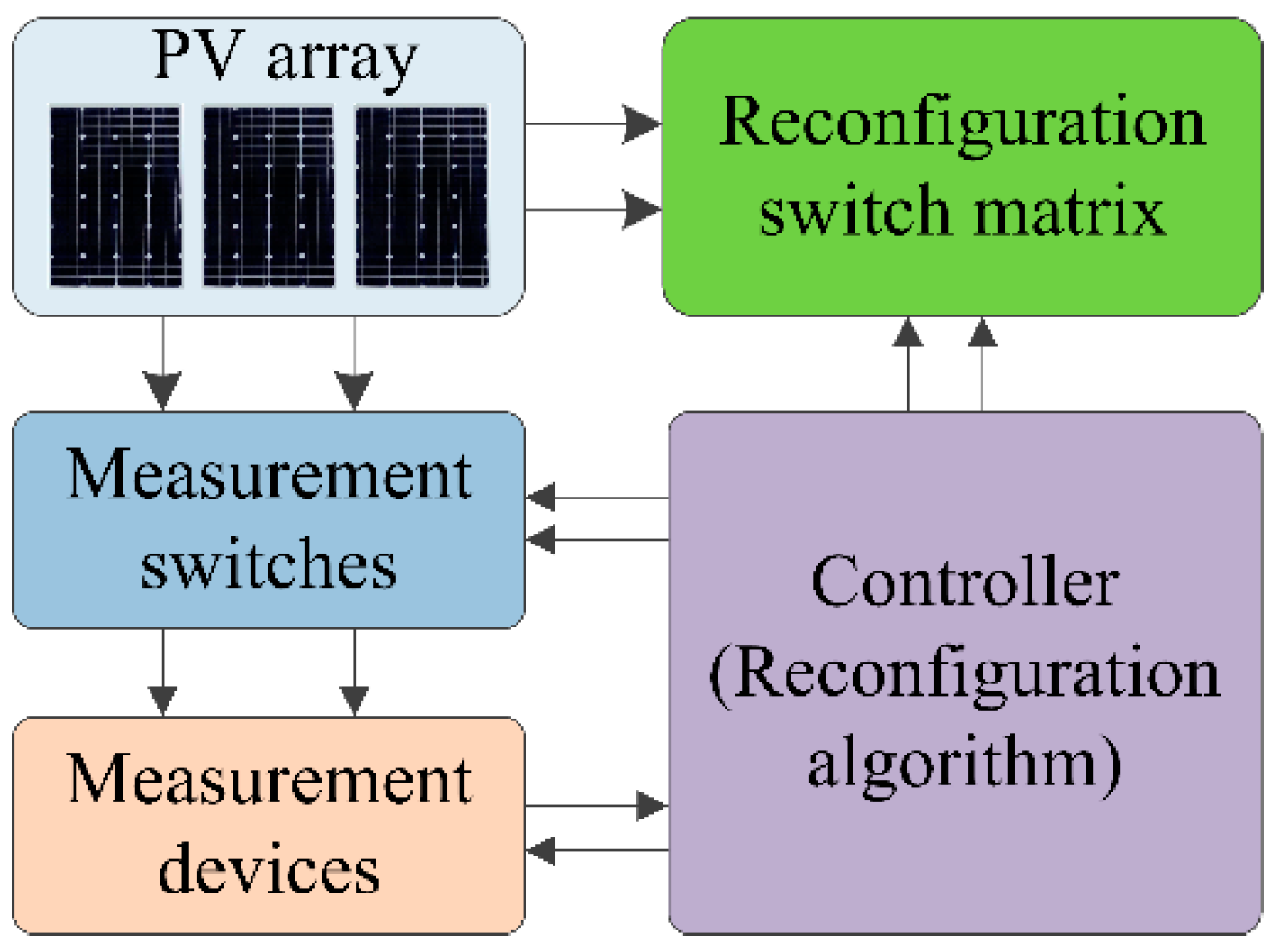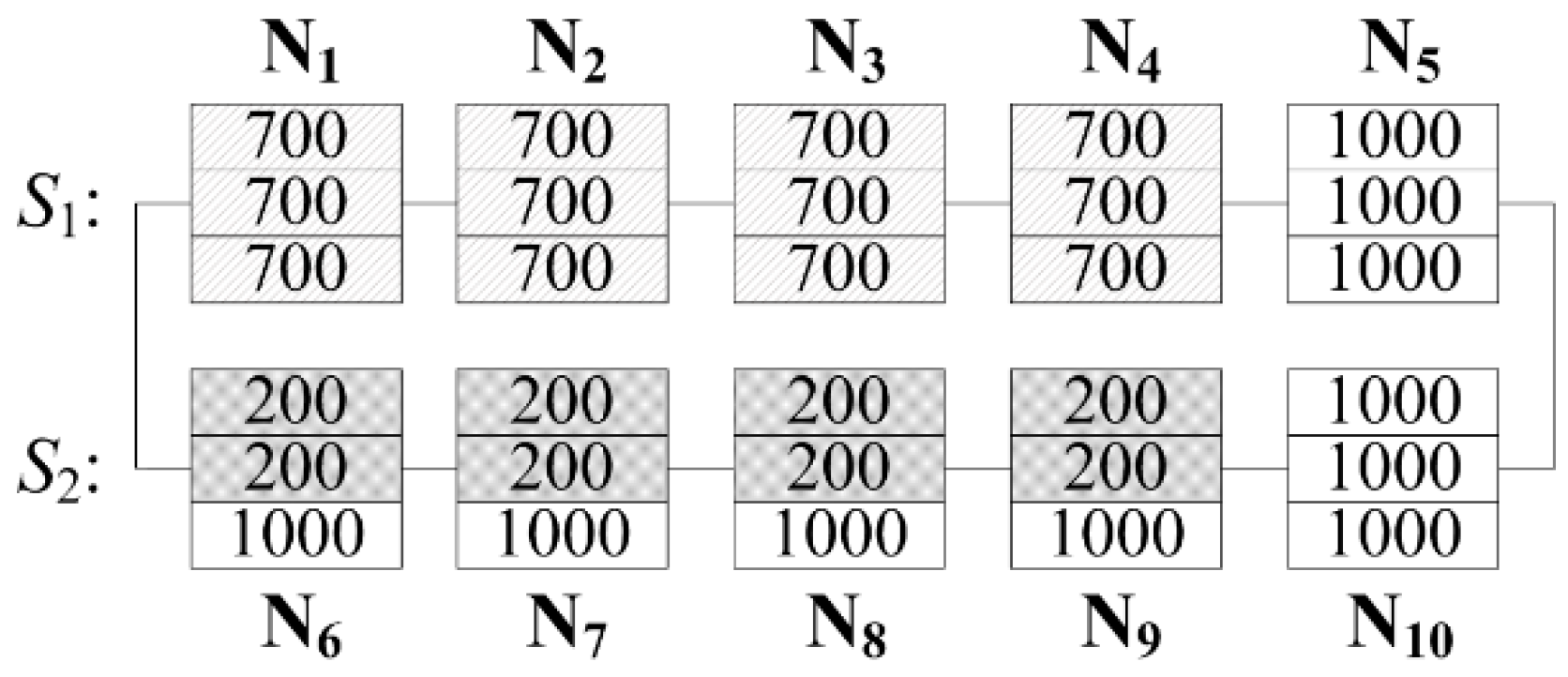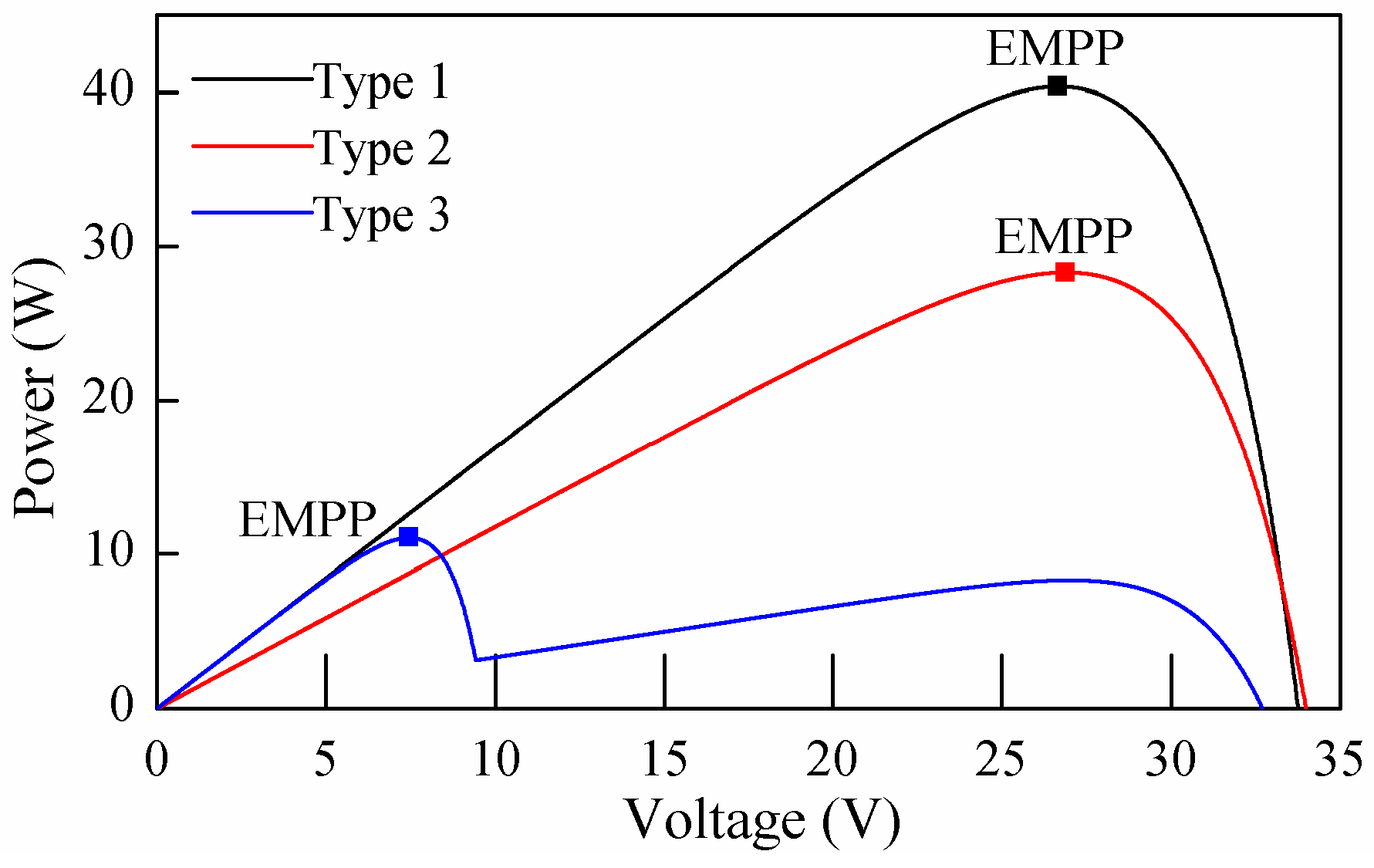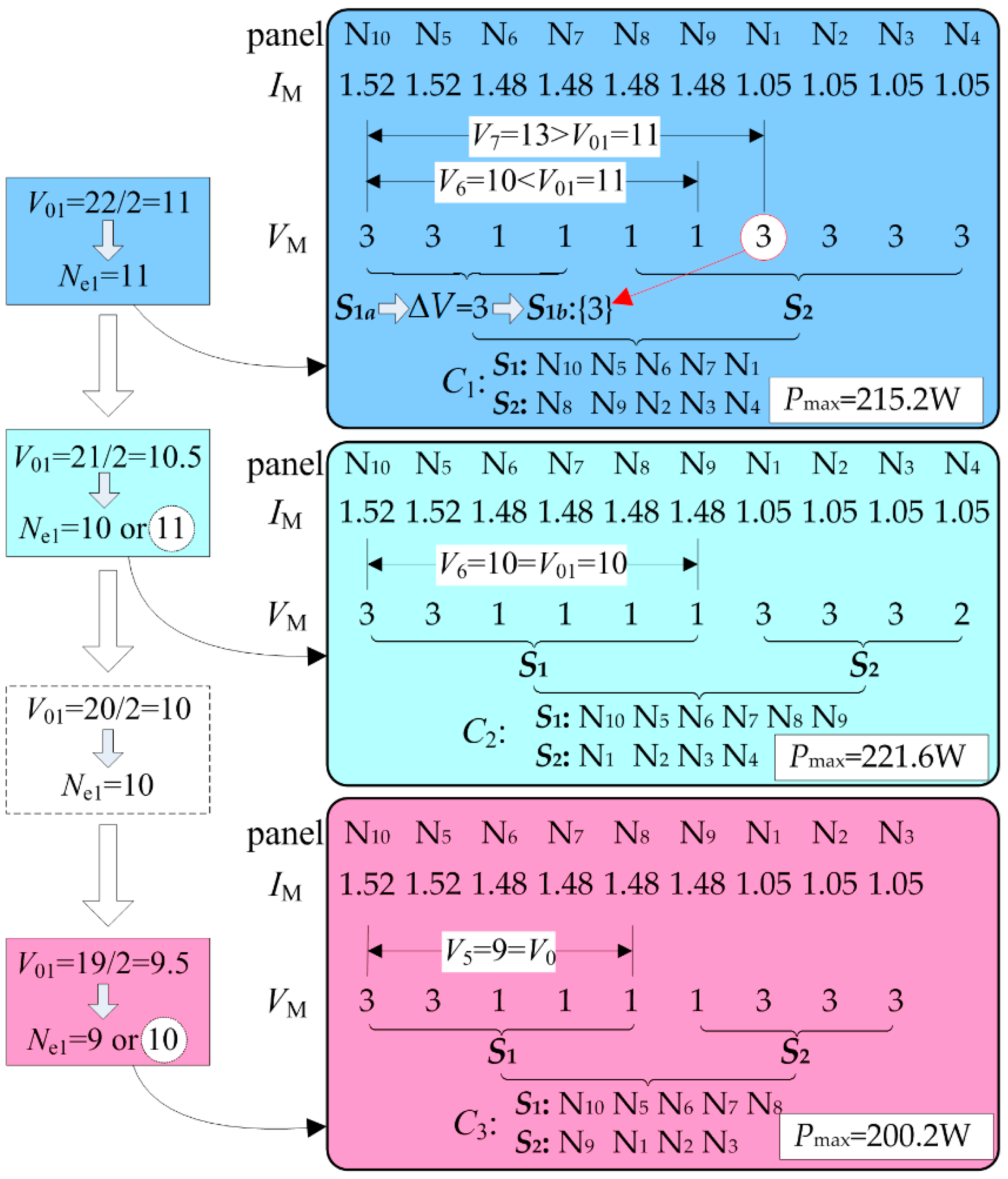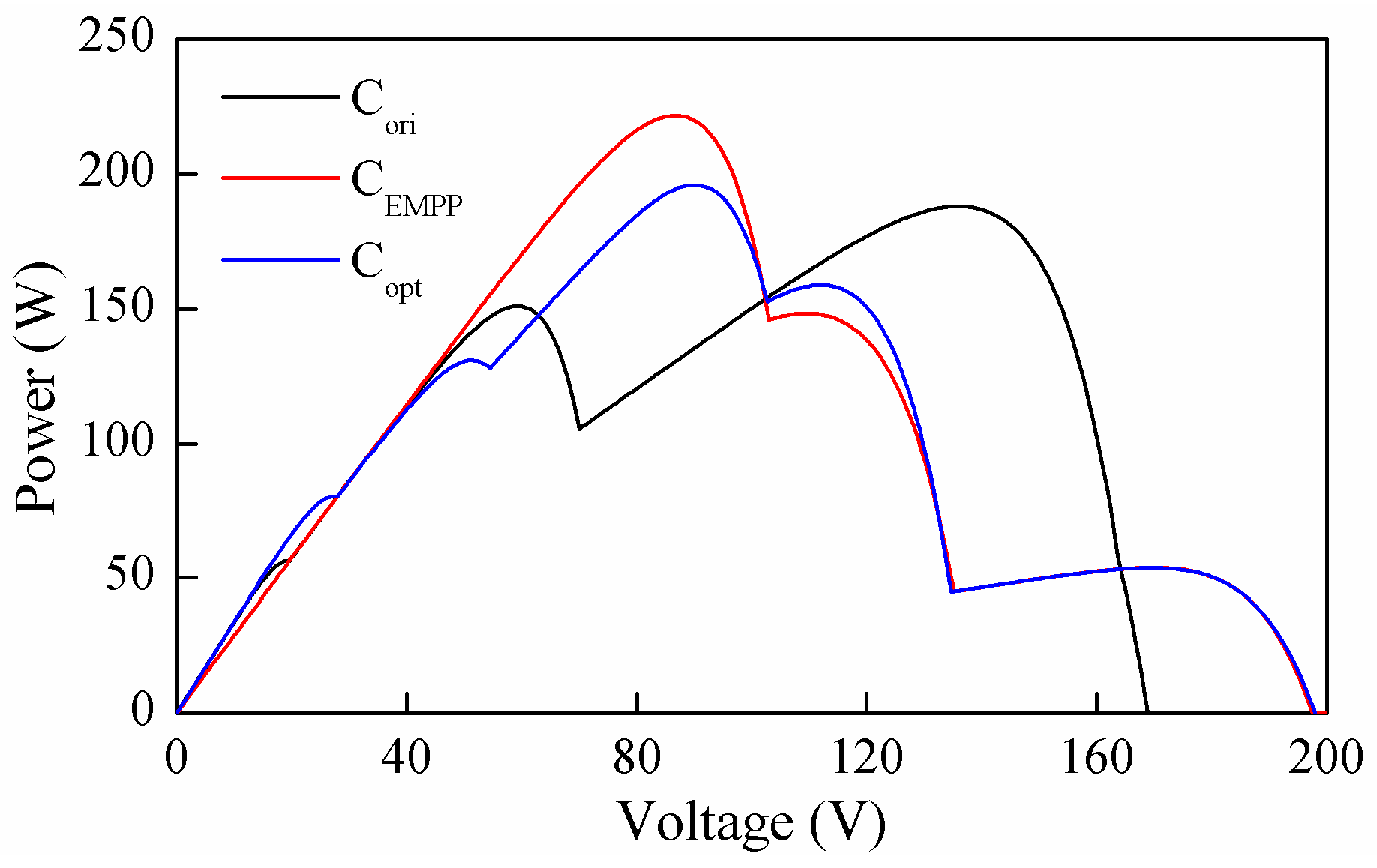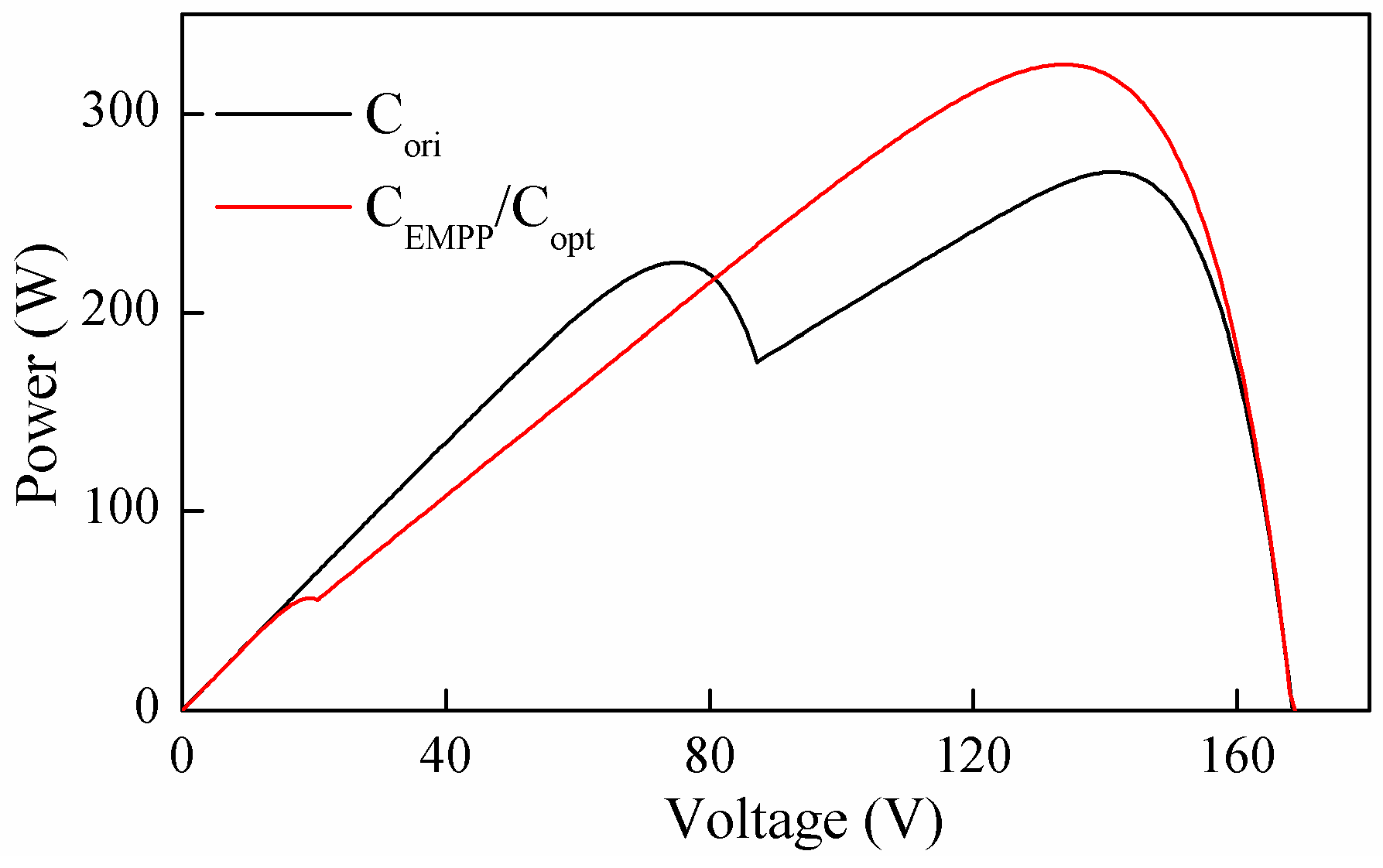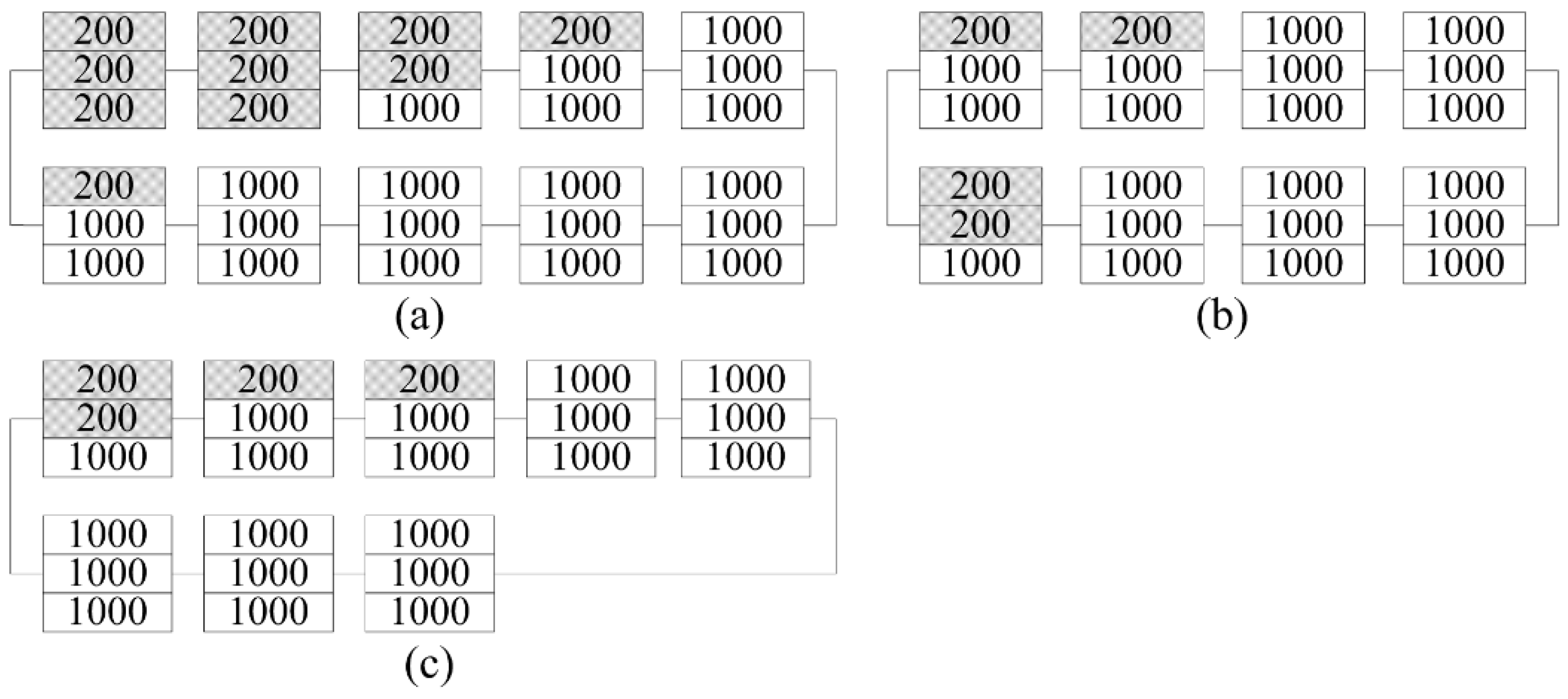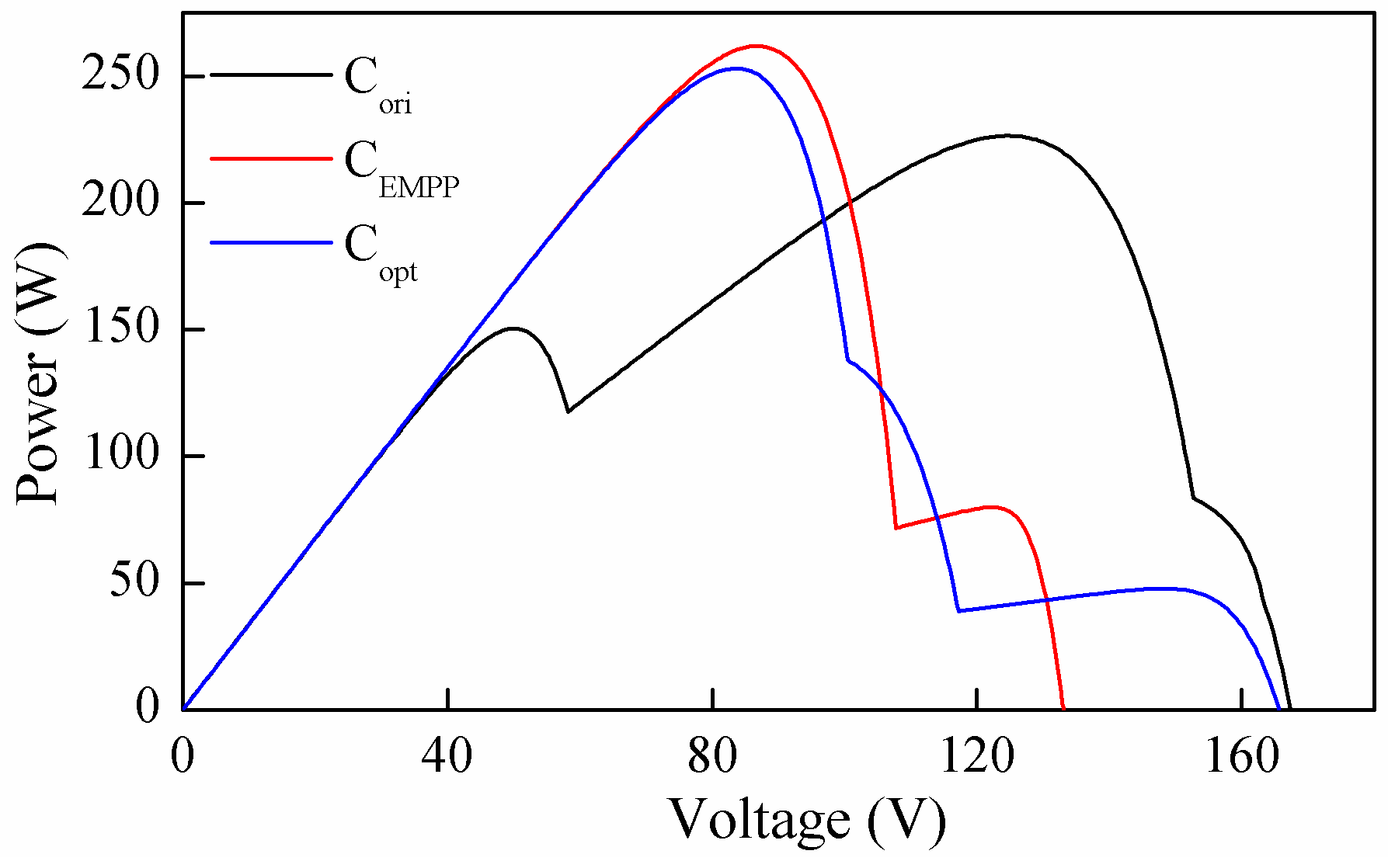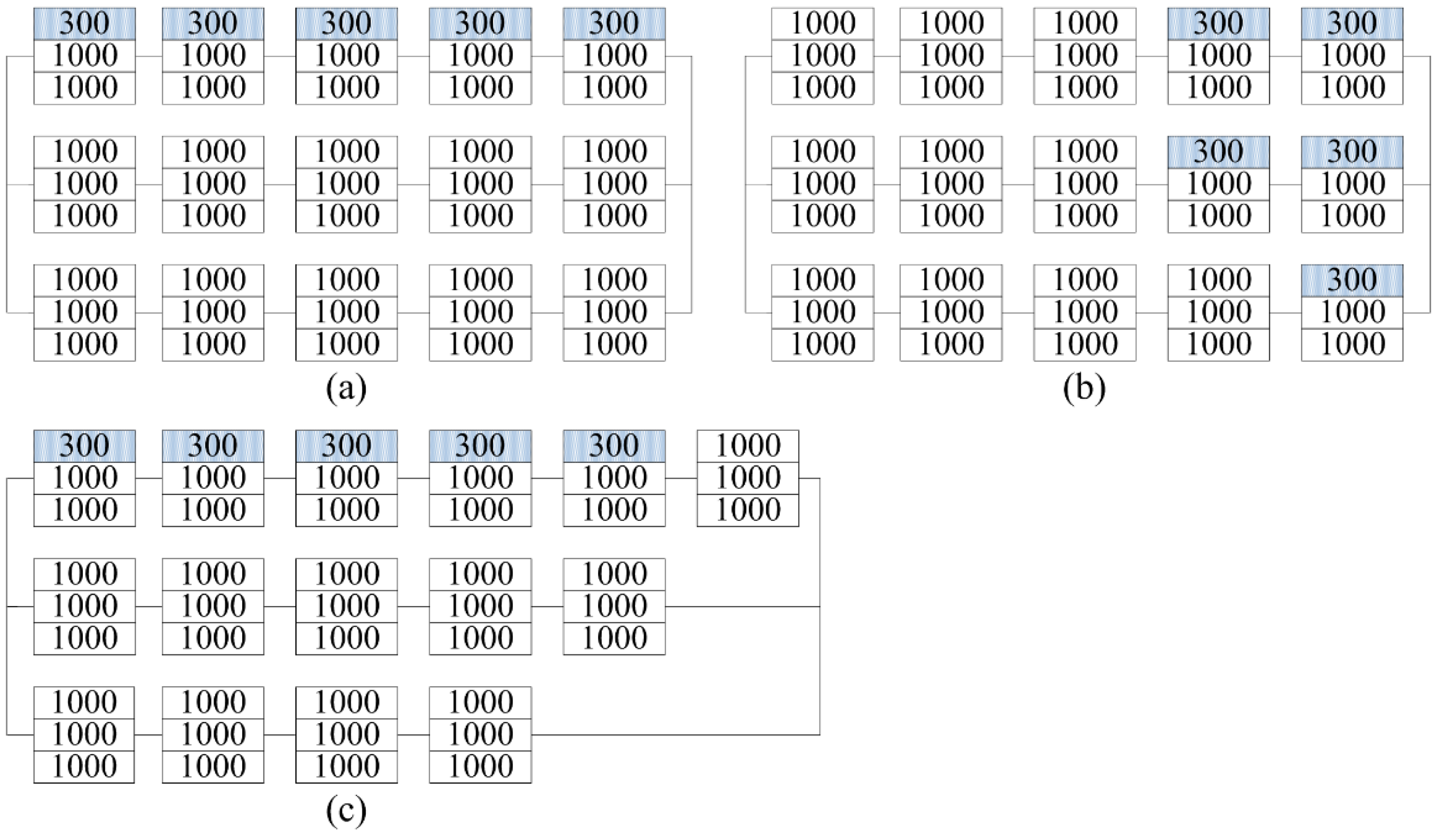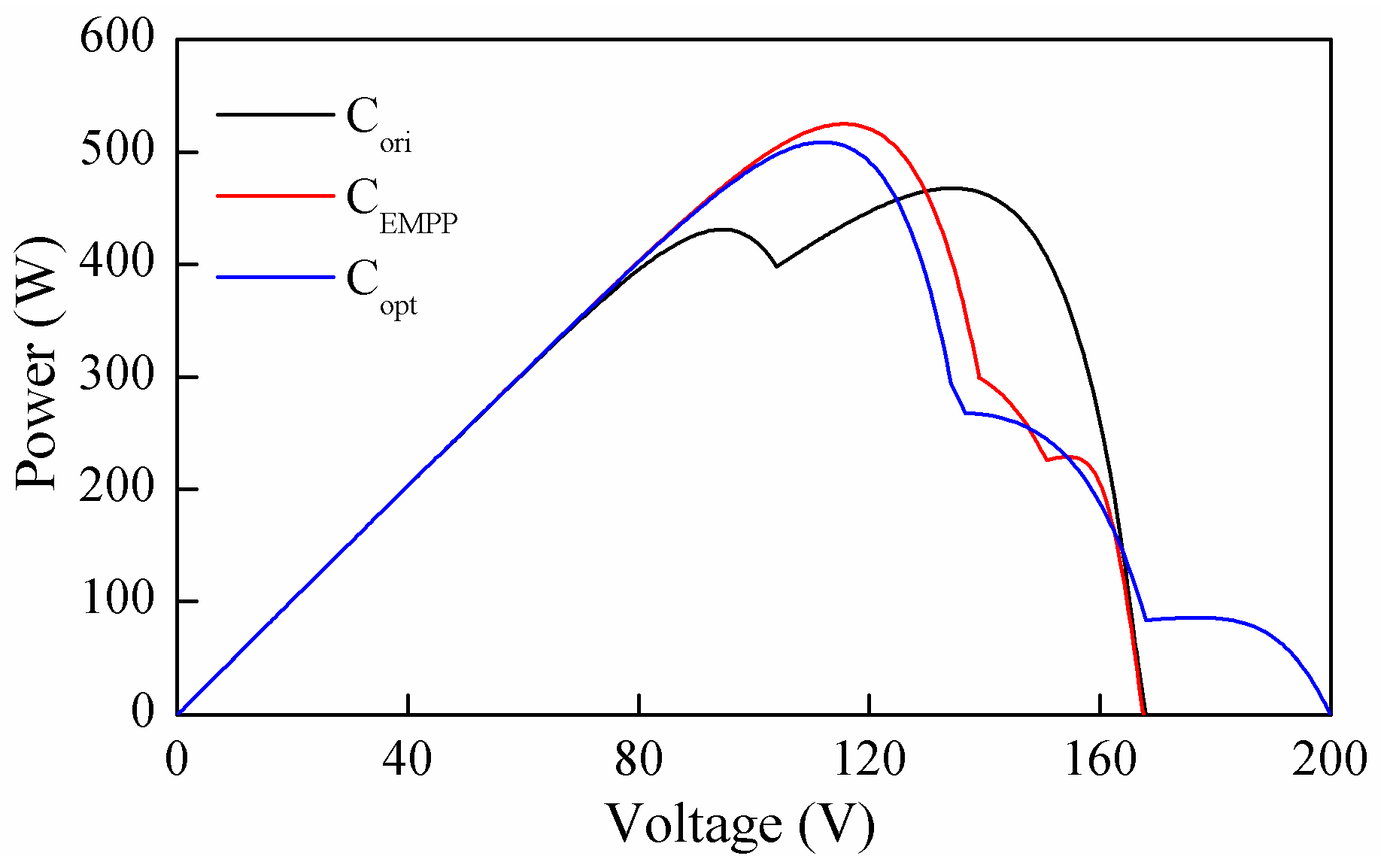1. Introduction
With the growing demand for electrical energy and environment protection, photovoltaic (PV) systems have drawn more and more attention since they can provide renewable and clean energy [
1,
2]. In its application, a PV array may be partially shaded due to clouds, buildings, trees, and bird litters, etc. [
3,
4,
5]. Under partial shade conditions, current mismatch and voltage mismatch can dramatically reduce the power generation of a PV array [
6,
7,
8]. In particular, if shading occurs at midday, when solar irradiation is high, the shadow effect would be significant [
9]. Apart from shade area, the power loss of a PV array under partial shade conditions is also related to the shade pattern and array configuration [
10]. Meanwhile, the power-voltage (P-V) curve of a PV array exhibits multiple peaks, only one of which is a global maximum power point (GMPP). This increases the difficulty in maximum power point tracking (MPPT) [
11]. To track the GMPP, multiple techniques have been used for MPPT, such as an artificial neural network [
12], fuzzy logic control [
13], the generalized pattern search method [
14], and the improved pattern search method [
15]. It should be noted that even when GMPP is tracked, part of the modules may not output power since the shaded modules may be short-circuited by the bypass diode [
16]. As a result, the extracted power of a PV array will be lower than it can deliver [
17]. Additionally, a mismatch problem can also lead to a hot-spot effect, which accelerates the degeneration of PV panels and increases the discrepancy of cell parameters. As a result, the mismatch problem is aggravated [
18].
To mitigate the drawbacks of a mismatch problem, various strategies have been proposed in reported literatures. Static methods aim to decrease mismatch losses without changing the configuration of the PV array. For example, researchers have studied the effect of the configuration of the bypass diode on the PV array [
19]. Furthermore, a new generation of bypass diodes with lower forward voltages are also applied to increase mismatch tolerance [
20]. On the other hand, different configurations of PV arrays have also been investigated to address mismatch losses (e.g., series parallel (SP), total cross ties (TCT), and bridge link (BL) [
21,
22]) and have found that the TCT arrangement shows the least mismatch loss in most cases. Both of these methods can improve PV array performance under mismatch conditions, although the improvement is limited by the fixed configuration of a PV array. Multi-tracker converters are also adopted for mismatch conditions [
23]. However, the high cost hinders its actual application [
24].
The dynamic method reconfigures a PV array by switching the switch matrix controlled by the reconfiguration algorithm. Shade is then dispersed within the whole PV array, leading to the decrease of mismatch loss. The working condition of a PV panel is needed for design in the reconfiguration method. In this paper, a PV module, panel and array are defined as follows: A PV module is composed of a certain number of series-connected solar cells anti-parallel connected with a bypass diode. Several series-connected PV modules are packaged to form a PV panel. Finally, a PV array is formed by parallel-connected PV strings consisting of series-connected PV panels. Some of the most commonly used variables to describe the working condition of a PV panel include irradiance, temperature and electrical parameters [
25]. In Reference [
26], irradiance of a PV panel is used to reconfigure the PV array. The irradiance is calculated using the short-circuit current and temperature of the PV panel. However, the method is only suitable for situations with uniform irradiance patterns. This can be explained by
Figure 1, showing the schematic diagram of PV panel subjected to different irradiance patterns. As shown in
Figure 1, an irradiance pattern may be divided into a uniform (a,b) or non-uniform irradiance pattern (c). Obviously, the irradiance pattern of a PV panel can be substituted by an irradiance value only when the irradiance pattern is uniform. In Reference [
27], the reconfiguration method is designed using the irradiance of each PV cell. Compared to Reference [
26], the method outlined in Reference [
27] is also suitable for non-uniform irradiance conditions. However, the method needs the irradiance of each PV cell, which is hard to acquire in actual applications. The other category of reconfiguration method uses the electrical parameters of a PV panel to reconfigure the PV array. In Reference [
24], short-circuit current is used to design the reconfiguration method. As shown in
Figure 1, a PV panel is composed of three modules. Each module is anti-parallel connected with a bypass diode. Under non-uniform irradiance patterns, the measured short-circuit current of a PV panel is the maximum short-circuit current of its three PV modules. Thus, the method described in Reference [
24] is also suitable for uniform irradiance patterns. In Reference [
17], the area enclosed between the power-current (P-I) curve and the I-axis of the PV panel is used to design the reconfiguration algorithm. An advantage of this algorithm is that it is independent of the irradiance pattern. However, the method considers all modules in the same PV panel as a whole. Under non-uniform irradiance pattern conditions, the irradiance patterns of the PV modules are different. Thus, reconfiguration of a PV array on the module level (rather than the panel level) can provide better performance. In Reference [
28], the MPP current and voltage of the PV modules are used to reconfigure the PV array. However, the reconfiguration of a PV array with more than two strings is not given.
Based on the analyses above, three factors must be considered in designing the reconfiguration method for a PV array composed of panels: (i) The method should be suitable for any irradiance pattern, i.e., uniform and non-uniform irradiance patterns; (ii) the reconfiguration should be carried out at the module level; and (iii) the method can be easily applied to a PV array with any number of strings. In this research, a new method is proposed to reconfigure the partially shaded PV array with SP topology, satisfying all three factors. The performance of the proposed method is investigated for different shade patterns and the results show better performance compared with the reconfiguration methods reviewed.
3. Proposed Reconfiguration Algorithm
3.1. GMPP Power of Partially Shaded PV Array
The power output of a PV array with SP topology is:
where
is the current of a PV string, and
is the voltage of the PV array. Under non-uniform irradiance conditions,
is different from
,
. The notation
represents the MPP voltage of a PV string, where the superscript
denotes the number of effective modules in the string and the subscript
j represents the
j-th string. If
is satisfied, the relationship between
and
can be sorted into two categories, which is illustrated by P-V curves of a PV array and its two strings, as shown in
Figure 5. PV string 1 is partially shaded. Specifically, it receives an irradiation profile consisting of two irradiance levels. Thus, the P-V curve of string 1 exhibits two MPPs: MPP
11 and MPP
12 in
Figure 5. On the contrary, PV string 2 is uniformly illuminated and therefore the P-V curve of string 2 exhibits only one MPP: MPP
2 in
Figure 5.
In the case depicted in
Figure 5, LMPP can be considered as the superposition of MPP
12 and MPP
2, which is the case when
is satisfied. In this scenario, the difference between
and
is small [
32]. Thus, the power of the PV array can be approximately expressed as:
where
. In each string, the current of MPP corresponding to
effective modules is approximately equal to the minimum
of all effective modules [
33]. Therefore, the maximum power is:
where
,
is the number of effective modules, and
approximately equals the minimum EMPP current of panels in
i-th string. Therefore, to maximize the power output of PV array, i.e., to get the optimal configuration, the maximized power output is:
From the analysis above, we can conclude that the MPP voltage difference can be neglected if the number of effective modules in all strings is the same. Therefore, the optimal configuration can be acquired as long as is maximized, which corresponds to the minimum current mismatch.
On the contrary, GMPP is the superposition of MPP
11 and MPP
2, which corresponds to the case when
is not satisfied. We may find that the voltage mismatch between string 1 and string 2 cannot be neglected since the voltage different between
and
is very large. Meanwhile, as depicted in
Figure 5, the voltage difference
between
and
is small due to the sharp decrease of the P-V curve on the right side of MPP
11. This indicates that the difference in the number of effective modules for different strings should be as small as possible. Therefore, the reconfiguration of a PV array can be executed in two steps: (i) Minimize the difference in effective module numbers among different strings; and (ii) maximize
on the basis of (i).
3.2. Proposed Reconfiguration Algorithm
Based on the analysis above, the detailed reconfiguration algorithm for a PV array with SP topology is shown as follows:
Step 1: Trace the I-V curve of PV panels by a suitably controlled DC/DC converter. Based on the recorded data, calculate the P-V curve by the linear interpolation method and find all EMPPs of the PV panel. EMPP voltages are simplified as the number of effective modules. Meanwhile, the interpolated data is also used to calculate the I-V curve of a PV string and array [
17].
Step 2: Determine the possible configurations of a PV array from the first string to the last string, successively.
Sub-step 2.1: For each PV panel, all recorded EMPPs are ranked in descending order based on their power. Take the first EMPP voltage and current of each panel to execute reconfiguration. Rank the EMPP currents in descending order, forming the EMPP current vector . Correspondingly, EMPP voltages should also be ranked based on the order of EMPP currents to acquire the EMPP voltage vector . Here, is the number of PV panels connected into the PV array.
Sub-step 2.2: Calculate the reference voltage of the
i-th string (
) and determine the number of effective module in the string. For the
i-th string, the reference voltage
is:
where
,
is the number of PV panels in a string. Supposing
rounds
to the nearest integer towards minus infinity and
, the number of effective modules in the
i-th string is determined as follows:
Sub-step 2.3: Determine the configuration of the i-th string. If the sum of the first f elements in equals to , i.e., , then the first f modules form the i-th string and the other modules form the rest of the strings. Otherwise, find the first f elements that satisfy and . The first modules are part of the i-th string . Other elements in are divided into categories. Supposing equals to 2, then the elements are in two categories, and . The elements in is j, where j = 1 or 2. Calculate the difference between and , i.e., . Select the first and elements in and to form EMPP voltage combinations . These elements satisfy , and the i-th string is the combination of and . After determining all panels in the i-th string, can be easily determined as the minimum EMPP current.
Sub-step 2.4: Delete the elements in S1 from the EMPP voltage and current vector. Return to sub-step 2.1 to determine the (i+1)-th string until the last string.
Step 3: Calculate the GMPP power, , of the reconfigured PV array. If decreases compared with the final configuration in the last iteration, stop the reconfiguration process—the configuration determined in the last iteration is the optimal configuration. Otherwise, update the EMPP with minimum current based on the following EMPP replacement rule and return to step 2:
1. If the PV panel with minimum MPP current only has one EMPP and EMPP voltage is 1, disconnect the PV panel from PV array.
2. If the PV panel with minimum MPP current only has one EMPP and EMPP voltage is larger than 1, the EMPP voltage is replaced with .
3. If the PV panel with minimum EMPP current has more than one EMPP, use the EMPP with the larger current to replace this EMPP.
The flowchart of the proposed reconfiguration algorithm is shown in
Figure 6.
4. Simulation Results and Discussion
The performance of the proposed algorithm was evaluated for different shade patterns in Matlab/Simulink. The PV array consisted of 10 panels, with each panel being composed of three series-connected solar modules. One bypass diode was anti-paralleled with the PV module. Each string was series-connected with a blocking diode to prevent current back flow. All switches were assumed to be ideal. The PV panels were interconnected through a reconfiguration switch matrix. By turning specific switches on and off, the corresponding panel was connected or disconnected from the PV array. Meanwhile, all of the PV panels were connected with measurement devices through measurement switches. When a specific switch was active, the corresponding panel was connected with its measurement device and, therefore, the I-V characteristics of the panel were measured. The complete simulated reconfiguration system is depicted in
Figure 7. The reconfiguration algorithm was executed by an S-function in the simulation. Note that in actual applications, the reconfiguration algorithm could be executed using digital processors like DSP or FPGA. When an updated measure of the panels’ I-V characteristics was required, the controller sequentially controlled each panel to be disconnected from the array (by the reconfiguration switch matrix) and connected to the measuring device via the measurement switches. After a complete scan was performed, the optimal configuration was determined by the reconfiguration algorithm. The optimal configuration was then acquired by controlling the reconfiguration switches. In this paper, C
ori and C
EMPP are defined as the original configuration and the reconfigured configuration by proposed method respectively. Meanwhile, to test its validity, C
EMPP was also compared with the optimized configuration, i.e., C
opt, in Reference [
17]. The reconfiguration efficiency was defined to quantify the performance of the reconfiguration algorithm as follows:
where
is the GMPP power of the PV array without reconfiguration and
is the GMPP power of the PV array after reconfiguration.
4.1. Case 1
A PV array composed of two strings with an irradiance pattern, as shown in
Figure 8, is considered in this case. The first four panels in the first string,
S1, receive uniform irradiance of 700
, while the first four panels in the second string receive non-uniform irradiance of 200 and 1000
. The temperature of the PV modules subjected to 200, 700 and 1000
is assumed to be 20, 35 and 44
, respectively. The ten panels are labeled as N
1 to N
10. Note that
Section 3 provides a detailed explanation of the reconfiguration steps, explicating the algorithm.
4.1.1. EMPPs for Reconfiguration
The first step was to determine the EMPPs of all of the panels. As shown in
Figure 8, there are three types of irradiance patterns for PV panels: Uniform irradiance of 1000
(Type 1), uniform irradiance of 700
(Type 2) and non-uniform irradiance with both 200 and 1000
(Type 3). P-V curves of three types of PV panels are shown in
Figure 9. For Type 1 and 2, there is only one MPP on the P-V curve. Therefore, this MPP is the EMPP. For Type 3, the P-V curve exhibits two MPPs. According to the definition of EMPP, GMPP is the only EMPP since the current of LMPP is smaller than that of GMPP. The EMPP voltage and current of Type 1, 2, 3 are 3, 3, 1 and 1.52, 1.48, 1.05, respectively. Thus, the EMPP current and voltage vector can be acquired as:
= [1.52 1.52 1.48 1.48 1.48 1.48 1.05 1.05 1.05 1.05],
= [3 3 1 1 1 1 3 3 3 3].
4.1.2. Determination of Possible Configurations
With reference to Steps 2 and 3, the process used to determine possible configurations is shown in
Figure 10. In the first iteration, the reference voltage and the number of effective modules for
S1 wats calculated as 11. Then the configuration of the PV array was determined following sub-step 2.3. Since
= 10 <
and
= 13 >
,
k was 7 and the first four panels formed part of the first string
. The rest of the panels were divided into three categories:
: [1 1],
T2: [] and
: [3 3 3 3]. The difference between
and
was calculated as
= 3. This meant three effective modules were needed to form
S1b. The possible combination could have been {1,1,1} or {3}. Only {3} could be acquired in this case. Thus, the first string configuration was {N
10, N
5, N
6, N
7, N
1} with a voltage vector [3 3 1 1 3], with the rest of the panels forming the other string. Using the interpolation method, we calculated the maximum power of the configuration,
C1, as 215.2 W.
In the second iteration, the EMPP voltage of N4 was changed to 2 in accordance with the EMPP replacement rule. The reference voltage of S1 was 10.5. Thus, the number of effective modules was 10 or 11. If = 11 was selected, the final configuration was the same as C1. Therefore, the determination of a possible configuration was given when = 10 was considered. Following sub-step 2.3, C2 was determined and its maximum power calculated as 221.6W. Since the maximum power of C2 was larger than that of C1, the reconfiguration continues.
In the subsequent iteration, the EMPP voltage of N4 was changed as 1. The reference voltage and the number of effective modules was calculated as 10. Since the EMPP current vector was not changed, the final configuration was the same as C2. Then, according to the EMPP replacement rule, N4 was disconnected from the PV array. By applying the same step above, C3 was determined and the maximum power of C3 was calculated as 200.2 W. Since the maximum power of C3 was smaller than that of C2, the reconfiguration process stopped, and C2 was selected as the optimal configuration for its maximum power among C1, C2 and C3.
The final configurations of C
EMPP and C
opt are shown in
Figure 11; the corresponding P-V curves are compared in
Figure 12. The global power point corresponding to C
ori, C
EMPP and C
opt is observed at 188.3 W, 221.6 W and 195.8 W, respectively. The reconfiguration efficiency of C
EMPP and C
opt is 17.68% and 3.98%, respectively. The improvement of C
EMPP compared with C
opt is attributed to a much smaller current mismatch in C
EMPP. For Type 3, GMPP was the only EMPP, which meant only the module subjected to 1000 W/m
2 was an effective module. For Type 1 and 2, all of the modules were effective. In C
EMPP and C
opt, the number of effective modules in
S1 and
S2 was the same, i.e., 10 and 12. However, the current mismatch of C
EMPP and C
opt were different. Since the reconfiguration using the proposed method was on the level of the PV module, the effective modules with the same irradiance were connected to the same string. This minimized the current mismatch. On the contrary, effective modules with different irradiances were connected in the same string using the method in Reference [
17], causing significant current mismatch of modules with irradiance of 1000 W/m
2.
4.2. Case 2
For case 2, the primary and optimized configurations are shown in
Figure 13a,b, respectively. In this case, the first two panels in both strings received an irradiance of 600 W/m
2 and the temperature of these panels was assumed to be 32
. As shown in
Figure 13b, the proposed and reference method provide the same result. According to the P-V curves shown in
Figure 14, the GMPP values obtained for C
ori and C
EMPP (C
opt) are 271 W and 325 W, respectively, which means 19.93% extra power is acquired.
4.3. Case 3
For this case, the primary and optimized configurations are shown in
Figure 15. The P-V curve of the PV array with a different configuration is shown in
Figure 16. The global power point corresponding to C
ori, C
EMPP and C
opt is observed at 226.5 W, 261.9 W and 253.0 W, respectively. Therefore, the reconfiguration efficiency of C
EMPP and C
opt are 15.6% and 11.7%, respectively. Also in this case, the proposed method had a better performance compared with the reference method. The improvement can be illustrated based on the difference between C
EMPP and C
opt, shown in
Figure 15b,c, respectively. In both configurations, two PV panels subjected to uniform irradiance of 200 W/m
2 were disconnected from the PV array. In the eight remaining panels, the module with an irradiance of 1000 W/m
2 was the effective module. In C
EMPP, 20 effective modules were evenly allocated in two strings, i.e., 10 effective modules per string. On the contrary, the number of effective modules for C
opt in two strings was 11 and 9, leading to higher voltage mismatch and therefore lower power output.
4.4. Case 4
A PV array with three strings was considered in case 4. The irradiance pattern is shown in
Figure 17a. The temperature of the PV module subjected to 300
was assumed to be 23
. The PV array reconfigured by the proposed method and the reference method are shown in
Figure 17a,b. The P-V curves of the PV array before and after reconfiguration are compared in
Figure 18. According to the P-V curves, C
EMPP and C
opt increases the power output from 467.8 W to 524.9 W and 508.7 W, respectively, corresponding to the reconfiguration efficiency of 12.21% and 8.74%, respectively.
4.5. Summary of the Simulation Study
The performance of the reconfiguration algorithm can be measured by two parameters: Reconfiguration efficiency and reconfiguration time. Reconfiguration efficiency is an important parameter since the main purpose of reconfiguration is to maximize the power generation of a shaded PV array. In the four cases, both the proposed and reference algorithms increased the power output. However, the proposed algorithm outperformed the reference algorithm in cases 1, 3 and 4 and showed the same performance in case 2. Correspondingly, the reconfiguration efficiency of the proposed algorithm was 13.7%, 3.9% and 3.47% higher than that of the reference algorithm in case 1, 3 and 4, respectively. Therefore, the proposed algorithm is able to extract more power from a partially shaded PV array, leading to greater power saving and more income.
Reconfiguration time also needs to be evaluated for the reconfiguration algorithm. The larger the time needed for the reconfiguration, the lower the frequency of reconfigurations and, consequently, the higher the probability of missing the possibility of adapting the module connections to the moving shadows in time. The reconfiguration time for the four simulation cases were 2.91 s, 2.78 s, 3.09 s and 3.88 s, respectively. The much longer reconfiguration time of case 4 compared with the other three cases was mainly attributed to more panels in case 4. From the results we can find that the proposed algorithm is suitable for cases where the shadow is caused by stationary objects, such as trees, buildings, poles and moving objects with very slow speed, such as moving clouds caused by wind with low speed.
